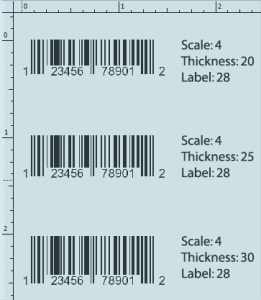Support this free on-line tool
[wcs_qr_code]

This utility can generate the following barcode symbologies: Code 39, Code 128, Codabar, EAN-13, EAN-8, UPC-A and UPC-E.
There are four variables when generating your barcode.
DPI: Dots per Inch – print resolution is 300 and our examples below were created at this resolution
Scale: This changes the width of your barcode.
Thickness: This determines the height
Label: Size of the type under your barcode graphic
By modifying the last three, you can determine, the height/width/typeface size.
Our recommendation is that you start at one of the sizes shown in the diagram and make modifications until you get to your desired size.
Terms of Service: This is a free service provide by this site. We do not provide any support. The use is permitted only for legal purposes and according to the valid regulations in the area where you are doing business. The functionality, output and availability of this free service can’t be guaranteed. If you are generating UPC and EAN barcode graphics, you must own those numbers. If you do not own your barcode numbers, we recommend www.nationwidebarcode.com or www.gs1.com.
Information about the provided symbologies
Code 39 (also known as Alpha39, Code 3 of 9, Code 3/9, Type 39, USS Code 39, or USD-3) is a variable length, discrete barcode symbology.
The Code 39 specification defines 43 characters, consisting of uppercase letters (A through Z), numeric digits (0 through 9) and a number of special characters (-, ., $, /, +, %, and space). An additional character (denoted ‘*’) is used for both start and stop delimiters.
One advantage of Code 39 is that since there is no need to generate a check digit, it can easily be integrated into existing printing system by adding a barcode font to the system or printer and then printing the raw data in that font.
Code 128 is a very high-density barcode symbology. (A special version of it called GS1-128 is used extensively world wide in shipping and packaging industries.) It is used for alphanumeric or numeric-only barcodes. It can encode all 128 characters of ASCII and, by use of an extension character (FNC4), the Latin-1 characters defined in ISO/IEC 8859-1
Codeabar: Originally developed by Pitney Bowes, the Codabar Barcode is used primarily by US Blood Banks, Photo Labs and Overnight Delivery Services. Codabar can encode the numbers 0 through 9, the start/stop characters A, B, C, D, E, *, N or T. and the six symbols (-:.$/+).
EAN-13 barcode (originally European Article Number, but now renamed International Article Number) is a 13 digit (12 data and 1 check-digit) barcoding standard which is a superset of the original 12-digit Universal Product Code (UPC) system developed in the United States.
EAN-8 barcodes may be used to encode GTIN-8s which are another set of product identifiers from the GS1 System.
UPC-A Barcodes are used for marking products sold in stores throughout the USA and Canada. The barcode is comprised of three groupings of numbers, the manufacturer ID (the company who owns the barcode prefix) which is 6, 7, 8 or 9 digits in length, the balance of numbers totaling 11 digits and the final 12th number (Check Digit or Checksum).
UPC-E is a variation of UPC-A which allows for a more compact barcode by eliminating “extra” zeros. Since the resulting UPC-E barcode is about half the size as an UPC-A barcode, UPC-E is generally used on products with very small packaging where a full UPC-A barcode couldn’t reasonably fit. Not all UPC-A Numbers can be converted to UPC-E
